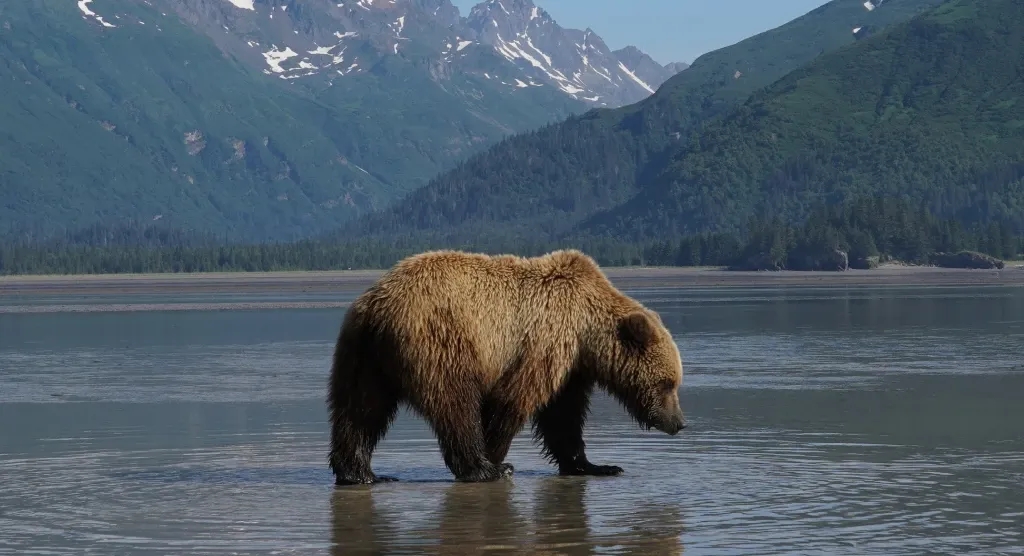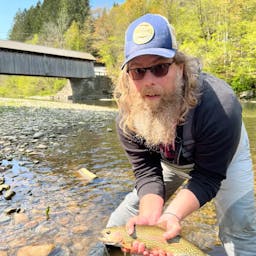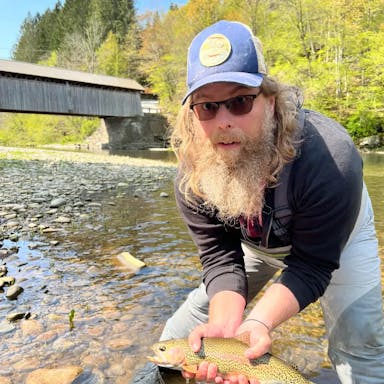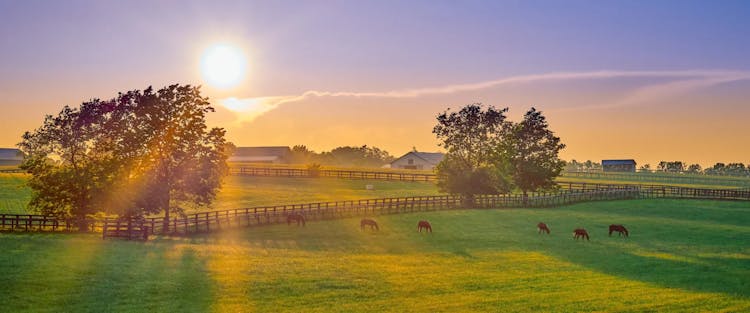
Viewing Coastal Brown Bears in Alaska
The hairs on my neck stood on alert as the massive coastal grizzly ambled closer and closer. I’ve watched brown bears like these in nature documentaries for years, but where once we were separated by a 55-inch Vizio television screen, now the only things between us were a few yards of grass and air. I could hear the breath escaping from his lungs as the nearly 1,000-pound bear moved to within a dozen yards or so.
But any fear I may have had quickly dissipated, replaced by an overwhelming sense of joy and awe. The bear sat, much like a kindergartner on a woven rug—to show he wasn’t a threat, explained my guide Brad Josephs—before beginning to graze on the meadow of sedge beneath him. The moment made such an impression on me that I’d later get a tattoo of that same bear on my leg.
The bear-viewing capital of the world

At the time, I was on a Natural Habitat Adventures trip to Katmai National Park & Preserve. Several years later, I did a second bear-viewing trip with the company to Lake Clark National Park.
Alaska is home to more than 70% of North America’s brown bears, and the stretch of the state's southeastern coast from Lake Clark National Park & Preserve to Katmai National Park & Preserve may offer the best brown bear-viewing opportunities in the world. Why? First, both areas have a particularly high concentration of bears. And perhaps more importantly, bears haven’t been hunted in these areas for generations, so they don’t fear humans. To them, we’re harmless, hairless curiosities, not prey. That mutual understanding and respect is what makes this area unique.
The key to maintaining that inter-species stalemate is predictability. As long as humans maintain their distance, don’t make much noise, and resist that unshakable urge to snuggle with the yearling cubs, the bears don’t have to remind them who’s actually the boss out here in the wilderness.
Choose your own bear adventure
Because you can reach this area only via plane or boat, the number of visitors is fairly limited (both Lake Clark and Katmai see fewer than 25,000 visitors per year compared to parks like Yellowstone and Yosemite, which each see more than 3 million).
You can visit on your own without a guide (though you’ll still need to pay for boat or plane transport to the parks), but it’s not recommended you travel outside of Brooks Falls unless you’re a bear expert. If you’re looking for a quick experience, a day trip will likely suffice. But if you’re looking for a safari-like experience with North America’s apex predator, then consider a multi-day adventure with an outfitter.
You can pretty much choose your own experience at Katmai—world-renowned thanks to the photos of bears standing and catching salmon in their mouths: Get dropped off at Brooks Falls for a day or three or travel into the park’s interior, where the bears congregate along the meadows and beaches bordering the bays. The former will give you an unforgettable image for Instagram, while the latter will give you a better understanding of the bears’ day-to-day lives.

The bear necessities
During my four-night stay at Bear Camp in Lake Clark, we had our pick of multiple viewing spots, depending on where the bears were congregating—sometimes just a few hundred yards from our camp. On any given day, we’d see a dozen or more bears grazing, fishing for salmon, or nursing their young. They were living their daily lives while we were living a tremendous adventure ripped from the pages of National Geographic.
Outfitters typically have strict rules to prevent coastal grizzlies from associating humans with food. (Remember the phrase: A fed bear is a dead bear.) At Bear Camp, no food or toiletries are allowed inside individual tent cabins; instead, they’re stored in a central, more secure location. The last thing you want to wake up to in the middle of the night is a brown bear rifling through your belongings, looking for your tube of Crest. (Fun fact: Bears love toothpaste.)
Over the years, I’ve learned a great deal about bear behavior from guides. Because adult male bears typically prefer to avoid humans, mama bears will often bring their cubs close to groups for security; this can lead to adorable photos of cubs wrestling while mama grazes on sedge in the background. One of my favorite memories is of a blonde cub charging toward us, before stopping and rearing up on his hind legs.
“He’s practicing a bluff charge,” I remember Josephs saying. “He knows we’re not a threat, and if he does get into trouble, his mom is right there to bail him out.”
Sometimes, a cub can get a little too curious about humans, but a few gentle admonishments from the guide—or a warning huff from mom—is typically enough to keep them away.
They’d be much more hard-pressed to keep me away.

Getting there
Most visitors fly into Anchorage’s Ted Stevens International Airport, then take a commuter flight to either Kodiak or Homer (the latter is roughly four hours from Anchorage by car). From there, you can do either a guided day trip or spend multiple days with an outfitter.
Average Going price for cheap flights to Anchorage: $303 RT
How to do it
- Best time to go: Most outfitters offer tours throughout June, July, and August. Some will do late May and early September as well.
- Cost: Expect to pay $800 or more per person for a 5-hour trip, including the flight time. A multi-day tour like the one at Bear Camp at Lake Clark National Park & Preserve will cost $6,600 and up, plus internal air. Room rates at Brooks Lodge in Katmai National Park & Preserve are $955 per night for up to four people; a lottery is held each year for bookings (2024 is already booked).
- Safety considerations: Coastal grizzlies in this area typically aren’t aggressive toward humans as long as they act calmly and predictably. Always follow your guide’s lead and under no circumstances run away from a bear, which may trigger a predator-prey response. (You wouldn’t like your role in that scenario.) Buying supplemental medevac insurance is highly recommended.
- Tips: Alaska can have unpredictable weather, so be sure to pack lots of rain gear, as well as clothes for a variety of temperature levels. Mosquitoes are considered the state bird of Alaska; bug spray is a must in summer. If you plan to do a day trip, try to schedule it as early as possible in your vacation; weather delays are known to happen, and it pays to be flexible.
More amazing experiences around the world:
Published October 10, 2023
Last updated January 9, 2024
Articles you might like
View AllTreat your travel to cheap flights
Most deals are 40-90% off normal prices with great itineraries from the best airlines. If it's not an amazing deal, we won't send it. Sign up for free to start getting flight alerts.




